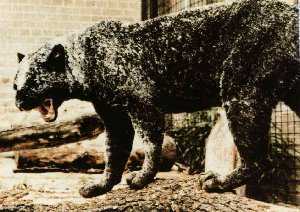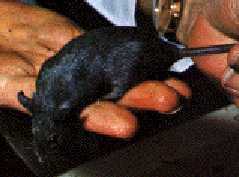
The Cobweb Panther of Glasgow Zoo

The black panther is not a separate species in its own right. In simple terms it is merely a leopard with an abnormal (mutant) gene form called non-agouti, which makes the background colour of its fur black or very dark brown instead of the normal tawny yellow. This phenomenon is called melanism. As a result, the black rosettes of its fur are often hard to see, unless viewed close up, or from certain angles in sunlight.
Black panthers are famous for their exotic beauty, but few can compare with the seemingly unique female purchased from Dublin Zoo during the early 1980s by Glasgow zoo, and exhibited there for a few years before being sold overseas probably destined for Madrid Zoo.
When first sighting it, you could be forgiven for thinking that this singularly eye-catching cat had recently strolled through an unusually dense sheet of cobwebs - because its entire coat appeared to be covered in a fine white filigree of gossamer. But on closer inspection you would see that this 'gossamer' was in fact a profuse sprinkling of white hairs among its otherwise uniformly black coat.
Black - furred mammals sometimes show a gradual silvering of their fur as they grow older, but this panther's silvering was so extensive that Richard O'Grady, director of Glasgow Zoo, is convinced that it was due to a genetic mutation. He also pointed out that its gums were unusually pink. Moreover, although the panther was 10 - 11 years old when it arrived in Glasgow, Richard had seen it some time earlier, while it was still at Dublin, and its silvering was no less pronounced then - again ruling out the explanation that it was going 'grey' with age. Because of this, we would assume that Glasgow Zoo's 'cobweb' panther's silvering was indeed caused by some form of aberrant gene.

A silver mutation has been reported in the mouse. On a nonagouti background, si/si mice have various numbers of silvered hair at birth. The silvered hairs are most readily seen on the head, behind the ears, and in their flank regions. With progressive moults as the mice age, more silvered hairs become apparent, but even in adult mice the extent of the silvering is highly variable. The phenotype results from the mixture of black, white, and black-and-white banded hairs.
 |
 |
 |
| Return to index | Return to Scottish Big Cats | Return to Wild Cats |